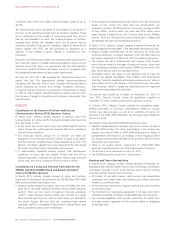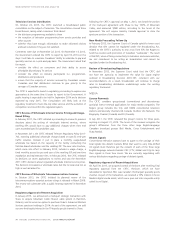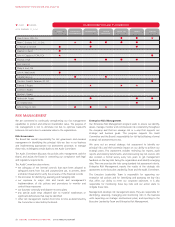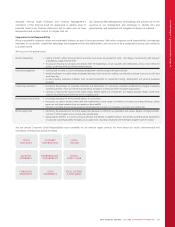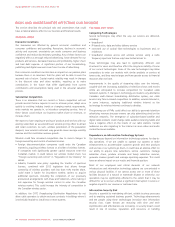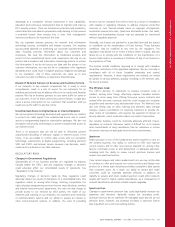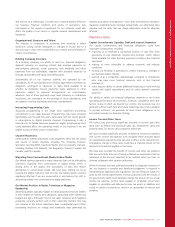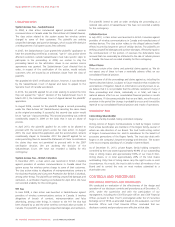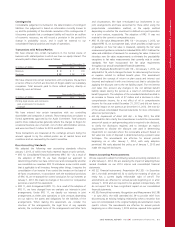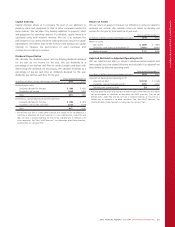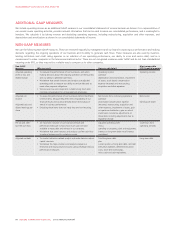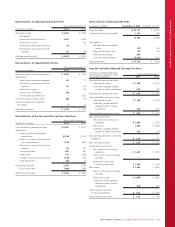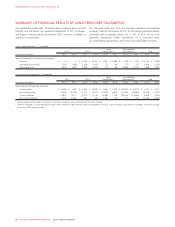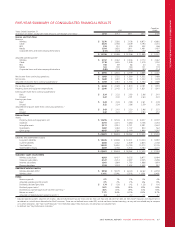Rogers 2013 Annual Report Download - page 81
Download and view the complete annual report
Please find page 81 of the 2013 Rogers annual report below. You can navigate through the pages in the report by either clicking on the pages listed below, or by using the keyword search tool below to find specific information within the annual report.
MANAGEMENT’S DISCUSSION AND ANALYSIS
and services on a timely basis, it could have a material adverse effect on
our business, financial condition and results of operations. Any
interruption in the supply of equipment for our networks could also
affect the quality of our service or impede network development and
expansion.
Organizational Structure and Talent
The industry is competitive in attracting and retaining a skilled
workforce. Losing certain employees or changes in morale due to a
restructuring or other event could affect our revenue and profitability in
certain circumstances.
Holding Company Structure
As a holding company, our ability to meet our financial obligations
depends primarily on receiving interest and principal payments on
intercompany advances, rental payments, cash dividends and other
payments from our subsidiaries, together with proceeds raised by us
through issuing debt and equity and selling assets.
Substantially all of our business activities are operated by our
subsidiaries. All of our subsidiaries are distinct legal entities that have no
obligation, contingent or otherwise, to make funds available to us
whether by dividends, interest payments, loans, advances or other
payments, subject to payment arrangements on intercompany
advances. Any of these payments must meet statutory or contractual
restrictions, are contingent on the earnings of those subsidiaries, and
are subject to various businesses and other considerations.
Increasing Programming Costs
Acquiring programming is the single most significant purchasing
commitment in our cable business. Programming costs have increased
significantly over the past few years, particularly with the recent growth
in subscriptions to digital specialty channels. Programming is also a
material cost for Media television properties. Higher programming costs
could adversely affect the operating results of our business if we are
unable to pass on these costs to subscribers.
Channel Placement
Unfavourable channel placement could negatively affect the tier status
and results of certain channels, including The Shopping Channel,
Sportsnet, SportsnetONE, Sportsnet World, and our specialty channels,
including Outdoor Life Network, The Biography Channel (Canada), G4
Canada, and FX (Canada).
Migrating from Conventional Media to New Media
Our Media business operates in many industries that can be affected by
customers migrating from conventional to digital media, which is
driving shifts in the quality and accessibility of data and mobile
alternatives to conventional media. We have been shifting our focus
towards the digital market to limit this risk. Our Media results could be
negatively affected if we are unsuccessful in anticipating the shift in
advertising dollars from conventional to digital platforms.
Our Market Position in Radio, Television or Magazine
Readership
Advertising dollars typically migrate to media properties that are leaders
in their respective markets and categories, particularly when advertising
budgets are tight. Although most of our radio, television and magazine
properties currently perform well in their respective markets, this may
not continue in the future. Advertisers base a substantial part of their
purchasing decisions on ratings and readership data generated by
industry associations and agencies. If our radio and television ratings or
magazine readership levels decrease substantially, our advertising sales
volumes and the rates that we charge advertisers could be adversely
affected.
FINANCIAL RISKS
Capital Commitments Liquidity, Debt and Interest Payments
Our capital commitments and financing obligations could have
important consequences including:
• requiring us to dedicate a substantial portion of cash flow from
operations to pay dividends, interest and principal, which reduce
funds available for other business purposes including other financial
operations
• making us more vulnerable to adverse economic and industry
conditions
• limiting our flexibility in planning for, and/or reacting to, changes in
our business and/or industry
• putting us at a competitive disadvantage compared to competitors
who may have more financial resources and, or less financial
leverage, or
• restricting our ability to obtain additional financing to fund working
capital and capital expenditures and for other general corporate
purposes.
Our ability to satisfy our financial obligations depends on our future
operating performance and economic, financial, competitive and other
factors, many of which are beyond our control. Our business may not
generate sufficient cash flow and future financings may not be available
to provide sufficient net proceeds to meet these obligations or to
successfully execute our business strategy.
Income Tax and Other Taxes
We collect, pay and accrue significant amounts of income and other
taxes such as federal and provincial sales tax, employment taxes and
property taxes, for and to various taxation authorities.
We have recorded significant amounts of deferred income tax liabilities
and current income tax expense, and calculated these amounts based
on substantively enacted income tax rates in effect at the relevant time.
A legislative change in these rates could have a material impact on the
amounts recorded and payable in the future.
We have also recorded the benefit of income and other tax positions
that are more likely than not of being sustained on examination and are
measured at the amount expected to be realized when we have an
ultimate settlement with taxation authorities.
While we believe we have paid and provided for adequate amounts of
tax, our business is complex and significant judgement is required in
interpreting tax legislation and regulations. Our tax filings are subject to
audit by the relevant government revenue authorities and the results of
the government audit could materially change the amount of our actual
income tax expense, income taxes payable or receivable, other taxes
payable or receivable and deferred income tax assets or liabilities and
could, in certain circumstances, result in an assessment of interest and
penalties.
2013 ANNUAL REPORT ROGERS COMMUNICATIONS INC. 77



